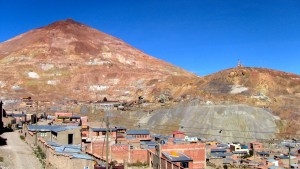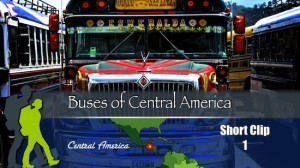Ethics Of Tourism: Mines Of Potosi Bolivia
| by Aracely | 15 Comments » | Bolivia, Reflections, South America
When I first heard that in Potosi there are organized tours allowing visitors to see how miners work, my first reaction was “Why? What do tourists do there, take pictures?”
At first thought, to be very honest, I was sickened that people do this. Imagine a group of gringos who are dressed in protective clothing, rubber boots, helmets and headlamps, which by the way are all likely better than the equipment the real miners are wearing, coming into the mines to take pictures and then getting back on the bus to continue their travels. It sounds so wrong. And then I heard that people bring gifts for the miners, such as dynamite, cigarettes, and coca leaves. “Is this to make the tourist feel better?” I wondered.
Jason felt differently than I. He really wanted to experience the mines and argued that it helps the miners when people visit. It gives them supplies that they desperately need, which is true. Further, it is an educational experience to be there and to truly know how atrocious the working conditions of the miners are. I reluctantly agreed to go because in all honesty, I still thought it was wrong. Right up to the moment when I entered the dark side of the archway that led into the mine, I did not want to be there.
Then, something changed.
As we walked deeper and deeper into the dark tunnel, I began to breathe heavily. I felt the dust in the air and could not catch my breath. The bandanna covering my nose and mouth was no match for the millions of dust particles fighting their way into my windpipes every time I inhaled. We were only a few meters in when suddenly, I wanted to be there–I wanted to see more, despite my labored breathing.
We continued into the mine crouching and dodging our way around wooden boards and low hanging rocks. Our guide Ronald allowed the group a few rests as he educated us on the history of The Candelaria Mine and gave details of a miner’s work and life. He told us that miners usually die of silicosis after ten to twenty years of working in the mines. They know the dangers that exist, but there are no other job alternatives in Potosi; the mines are the economy of the city. They do it to feed their family, explained Ronald. He also told us about El Tio. When they enter the mines, miners believe they need to worship the devil. They give El Tio offerings to keep them safe from accidents and they ask him to give them quality minerals. Every mine has a statue that represents the devil, he continued. My skin crawled.
As he talked to our group of five tourists (three Americans and two Australians), a miner walked by and Ronald engaged him in conversation to further educate the group.
Talking to a miner
Guide: What’s your name?
Miner: Fausto.
Guide: How old are you?
Miner: Twenty-nine.
Guide: How long have you been working in the mines?
Miner: Eight years.
Guide: How late will you be working today?
Miner: Until about 6pm, a total of 10 hours.
We gave Fausto some coca leaves and a pair of leather gloves. Even though our guide instructed that we only needed to buy some dynamite kits, refreshments, and coca leaves, Jason and I decided to buy some protective gear for the miners as well. We bought five pairs of leather gloves along with a sophisticated mask to give to one lucky miner. This was my way of making me feel less guilty for visiting the mines.
A scary moment
Once everyone had a bit of a rest, we were told we would move on to the second, third and finally the fourth level below us. We all followed Ronald. Tourist groups spend a large part of the tour crawling on hands and knees over hard rocks that jam into your skin while maneuvering through the dark cramped tunnels. Often, we had to climb down or up poorly rigged ladders which made it very dangerous for everyone. Our headlamps lit the way. One occasion, I lost my footing and slid ten feet down a black passageway. I bounced into the rock walls from left to right like a pinball making its way down an arcade machine. There were only a few scrapes and bruises, but it was one of the scariest ten seconds of my life. El Tio must know I did not want to come, I thought.
My initial thinking was that mining should not be treated as a tourist attraction. After being a part of a tour I realized that although people did take pictures, most of the tour was educational and serious. We spoke to six different miners, asking them the same questions and gave them all the dynamite kits, soda, and coca leaves that we purchased at the miners market earlier in our tour. Overall, it was an overwhelming, emotional and once in a lifetime experience to say the least. I am glad I went. There is a world of difference between hearing about how the miners work and actually going into the mines to feel yourself inhaling rock and mineral dust.
However, I still have an unresolved ethical conflict with mine tours even after I experienced them first hand.
First, tourists feel the need to take pictures and I am not completely convinced miners want their pictures taken. Our guide repeatedly encouraged us to take pictures of the miners working and sweating in the dark dusty tunnels. He was reassuring us that it was okay with the miners that their pictures were being taken. From what I could gather, the workers did not seem very thrilled about this. The cooperative miners are not paid on an hourly basis, they are paid on the quality and quantity of the minerals they extract and we are likely a distraction. I did not ask any miners specifically if the pictures bothered them. This is just my interpretation of their body language, although when they were asked by the guide how they felt about the tourists being there, they all smiled in approval. Perhaps banning pictures in the tours would make me feel better, I’m really not sure.
Second, only a few miners benefit from the tour visits. To maximize safety, the tours only visit a small part of one particular mine. I completely understand and agree with this practice. However, there are currently about twelve thousands miners working in over a hundred active mines at Cerro Rico, the mountain which dominates Potisi’s skyline. In our van there were a total of seventeen tourists broken up into three groups. All three groups visited more or less the same miners and gave them all gifts. It would be great if more miners could benefit from the tours being conducted. I do not have the solution as to how this would happen, but I am trying to think of one.
Third, at the end of the tour there was a dynamite demonstration for the tourists. I will admit it was shocking and somewhat exciting to hear and feel the force of the dynamite exploding but the delivery of the demonstration was sensationalized and felt like a spectacle too soon after a very somber experience. Our guide even egged us on to take pictures with the live bomb. I refused but others did partake in the fun activity.
Lastly, I understand that the mines are the sole livelihood of the men in Potosi. I understand that charity is not an answer and maybe the only thing that can change the miners’ destiny is creating a different economy in the city or something equally drastic. Can visitors do more? Is being aware of the miner’s horrific working conditions or creating awareness all we can do to make a difference?
Again, I am glad I decided to go, however I realize that nothing has changed for the miners. They did show their appreciation for the gifts we brought, but the tour bus still rode off away from the mines with our protective clothing and bright headlamps. The miners were still left behind in the dark with toxic dust breaking down their lungs. These tours change nothing for them and we tourists should not make pretend it does, even if we did bring them supplies and refreshments.
Visiting the Mines
If you decide to take a mine tour during your visit to Potosi, Bolivia, I suggest that you buy a little more than refreshments and dynamite kits. One protective mask costs about 50 Bolivianos ($7 USD) or perhaps some leather gloves, which are 10 Bolivianos ($1.5 USD) a pair. These will not change the destiny of the miners, but at least they protect them a little bit more from the toxic dust while performing their life’s work.
A friend (and mentor) continues to remind me, “Do not let the perfect be the enemy of the good.” I do not believe the tours are changing the conditions of the miners, but for those tourists who choose to visit the mines in Potosi, I guarantee something in you will change after this experience and the miners will appreciate any gift you bring them. The tours are not perfect but perhaps they are still good, I will leave it to the tourists to decide.
If visiting Bolivia is not in your current plans but you are interested in learning about the Potosi mines, I recommend the touching film “The Devil’s Miner,” where a fourteen year-old boy tells the story of his life as a Potosi miner.

























I feel the same as you. It’s a dilemma that I often face when traveling. If I go I feel like an intruder, if I don’t, it feels like I don’t want to see the ‘real’ life. I agree that gifts don’t change anything. Why not ask for an entry fee that goes toward better protective gear or living conditions down there? I don’t have the answer either but coca leaves for a few or awareness alone doesn’t change a thing.
I know we talked a lot about the mine tours and the ethics of this during the time we shared driving around northern Argentina. It’s a really difficult ethical question and one without a clear black or white answer. Like you, I was glad that I went on the tour because I don’t think I would have really understood what their work and life was like without experiencing the dust, shortness of breath and chemicals myself. And, I knew what we were experiencing was the easy stuff since we only went a couple of levels deep while miners were working many levels below us in much worse conditions. While on our tour, we met a 12-year old kid who was in the middle of a 14-hour trek. That was heartbreaking – as we talked to the guide and other locals later, he probably doesn’t have a choice because he is responsible for supporting family (like in the movie Devil’s Miner). As you said, the miners don’t want charity and are proud. But, what is a shame is that there are usually no other economic opportunities in town to offer alternatives to young people.
Like you, the dynamite explosion at the end of a sobering and educational experience really bothered me. But, I did feel that the tour did a good job otherwise providing information and an understanding of the history and present situation of the mine and city of Potosi.
Thanks for the comment Audrey. I am glad we didn’t see a kid working that day. My brother is 14 and that would have been really heartbreaking for me, as I know it was for you. I agree with you and I did mention above that most of the tour was done in an educational and serious manner, but for me that’s just not enough. It could be the best conducted tour in the world. The miners are still not benefiting much from them. That is my big issue. I hope your visit to the US is going well. Jason and I miss the times we shared with you and Dan in northern Argentina!
Interesting read and I am torn as it seems are you.
So sad about the health risks. Again poverty causes premature death in workers.
Lets hope that if enough people hear about these conditions something will get done.
Thanks for sharing your experiences.
I saw this through Cathy Browns Tweets
Great post Aracely, world sometimes is unfair.
Aracely, like you, I am torn. Before *every* decision I have to make in my life, I ask myself if I am helping or causing harm. It’s often pretty easy to figure the answer to that question out. On this issue, I am truly stumped. It’s certainly been my experience that a lot of tourists can use the notion that they’re “helping” when really, they’re just curious or perhaps even *morbidly* curious. My partner and I went on a favela tour in Rio and for us, it was amazing. It broadened our perspectives, and we got to see a school that is built and maintained using the money from the favela tours. But still…..I don’t know how I would feel if *I* lived in a favela, and tourists came to my neighbourhood to take pictures, so that they could go back to their comfortable lives in a developed country and show their loved ones the deplorable living conditions that exist in my part of the world. I honestly don’t know how I would feel. While I loved the favela tour and am grateful for the learning that came from it, I am also aware that there is a chance that my learning and my expanded perspective *could have* come at the expense of someone else’s dignity. It’s a tough one, forsure. I love, love, LOVE this entry. Thank you for sharing it with us.
Wow, this was fascinating. I had the same feelings you did when I was taken to a silk factory in China. I just remember being so confused and not wanting to go. But in the end, I had joined a group as a solo traveler and didn’t want to get lost. And that impact wasn’t nearly as dramatic as this one. Thank you so much for sharing.
In 1975, two female friends and I (also female) were among the first women to takea tour of this mine, largely against the wishes of the miners who thought women were bad luck.
No gifts, but we gave small amounts of money to the miners we spoke with. No photos.
Our transport was an “elevator” — small square wood platform with no sides, cable in a hole in the middle.
Equipment for us tourists was better even then than what the miners had.
Change comes slowly, if at all.
It must have truly been a unique experience for you girls. Thanks for sharing this with us and the readers. It puts it in perspective that even then, your equipment was better than theirs. Change is slow there, if it comes at all.
Between this and Christine’s “Sh*t I didn’t do in Thailand” post, I realize I have a lot of thinking to do when it comes to ethical traveling. Goes back to childhood when your parents and teachers used to ask, “If everyone jumped off the cliff, would you?” I don’t know why that question doesn’t get asked more when it comes to tourist attractions. It should. Great article!
BTW, where did you get the items for the miners? Was there a store outside of the start of the tour?
There is a miners market lined with vendors selling all the miner supplies, mostly soda and coca leaves. If you participate in one of the tours, they will allow you to spend time here to purchase supplies.
The tour into the Cerro Rico mines remains one of my most memorable experiences after about four years travelling and living in South America. It’s a haunting experience, and the images of the tour really imprint themselves on your memory. I watched a father and son hammering away at the mine face, driving a metal rod into the rock so that they could slide in a stick of dynamite. The son was about 13 or 14 years old. The father looked like he was made out of blackened bronze, one of the toughest looking men I’ve ever seen. There was something almost mechanical about him as he hammered away, completely ignoring us interlopers.
I would never tell anyone not to do the Cerro Rico tour, but it is a demanding experience both physically and mentally. If I remember correctly, the tour I went with gave a percentage of their earnings to a miner’s fund, and the guides were former miners themselves. That seemed to be a decent arrangement. Buying dynamite, coca leaves etc helps the miner’s financially, but I really like your idea of buying gloves and masks.
Thanks for sharing your experience Tony. Yes, the tour guides were former miners and our tour company contributed to a fund that through a party every year for the miners and their families. I don’t think that is the best use of their money, but it’s what they did. It is a physical and mental challenge.
I recently had a similar experience cisiting the families that work and live in Central America’s largest landfill. Taking photos of 11 year old kids working in the dump was tough, but I did it anyway telling myself that sharing awareness of the situation was worth it.
But was it really?
The questions that we constantly ask ourselves, and probably never know the correct answer too. I think we each have to chose what we think is best in our own opinion. So if you decided it was a good idea, then it most likely was. The main thing is that you thought about it, and that matters.